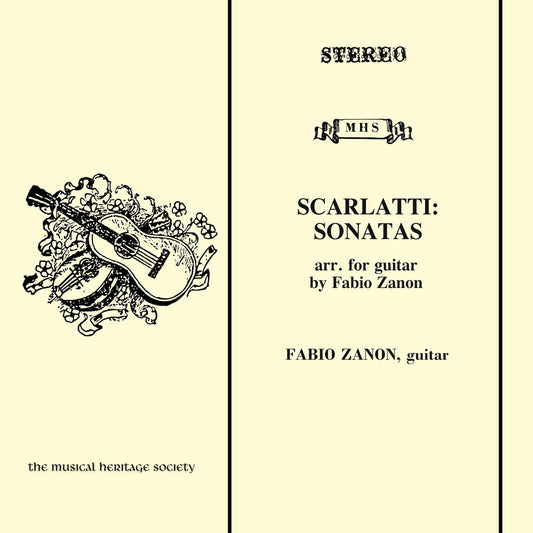1
/
of
1
FABIO ZANON: THE MUSICAL HERITAGE SOCIETY RECORDINGS
Villa-Lobos: The Complete Solo Guitar Music - Fabio Zanon, guitar
Villa-Lobos: The Complete Solo Guitar Music - Fabio Zanon, guitar
AVAILABLE ON MAJOR STREAMING SERVICES
For four hundred years Brazil suffered the problem of colonialized imagination, where local talent has difficulty in expressing itself. The artistic production was not nourished by direct experience and natural environment, remaining dependent on alien values imported from Portugal until 1889, when it became a republic. It was the role of the generation of artists who came to prominence in the 1900s to develop a national artistic conscience, and Heitor Villa-Lobos (1897-1959) was the most universally acclaimed of them. He was born in Rio de Janeiro, the son of an intellectual who taught him to play the cello. After his death the young Heitor learned to play the guitar, an instrument associated with the lower ranks of society. In 1906 he embarked on a legendary trip to the North of his country; he travelled across the coast as far as Manaus, in the Amazon, meeting the humble people and intuitively absorbing their habits and rich musical folklore; later in his life he would exaggerate facts from this trip, inspired by the scientific expeditions that were taking place at the same time. Back to Rio in 1910, he married a pianist and tried (unsuccessfully) to catch up with his musical education as a "serious" composer, while working as a free-lance musician, playing at the opera house at night and in cafes during the day. His earliest known guitar works, which now comprise the "Suite Populaire Bresilienne", belong to this period. At the time of Villa-Lobos' youth Brazil still was in the process of assimilating the foreign influences that would result in its rich popular music. Until that time, entertainment music consisted of imported European dances: waltzes, polkas, mazurkas, schottisches, and there was no distinction between a popular and a schooled composer. In 1888 slavery was abolished and the interaction of musicians of different classes increased. This is the time when two genres, the "choro" and the "seresta" (serenade), are developed, and when the gap between "classical" and "popular" music is established. Musicologists dispute over the origin of the word choro (Portuguese for weeping); some think of it as a corruption of the word "chorus" as a designation for instrumental group, others affirm that "xolo" is an African word for dance. Still today, choro musicians employ the expression "to weep on the trebles" or "to weep on the bass", underlining its sentimentality. Initially the name was given to the instrumental groups that played this hybrid music; later, it was applied to the music itself. From the beginning, choro was an instrumental genre, characterized by the presence of a soloist (generally a flute or clarinet), a rhythmical continuo (marked by a cavaquinho or soprano guitar) and a restless bass line (usually two guitars); the level of technical accomplishment was high. This genre was dominant in the urban centres for fifty years, giving way to the mass appeal of the "samba" in the 1930s; nowadays it is seen by the great public as something of the past, but it is still cultivated by a great number of initiates. According to Donga, one of the major choro personalities, Villa-Lobos was a virtuoso "both as a soloist and as accompanist, a great, great improviser; a mediocre player was not allowed to those circles".

Fabio Zanon, a Brazilian who has lived in London for some years, must now be acknowledged as a member of the highest echelon of living guitarists — an accolade I do not bestow lightly. His playing is marked by fluent technique, great beauty and variety of sound, finely controlled emotional response, and stylistic sensitivity. In short, he is an artist of the highest calibre. The technical idiosyncrasies of the guitar make it hard for the listener to concentrate solely on the quality of the music and its interpretation: Zanon, for whom technical problems seem not to exist, enables one to do this with ease. Superb recording and good annotation complete a memorable issue.
Gramophone
11/29/2024
Performers

00:00
/
00:00
•
skip_previous
play_circle_outline
pause_circle_outline
skip_next
Also Available from The FABIO ZANON: THE MUSICAL HERITAGE SOCIETY RECORDINGS
-
Members Save 50% MHS EXCLUSIVE DIGITAL DOWNLOAD
Playlist: Guitar
ExploreRegular price $9.98Regular priceUnit price / per$9.98Sale price $9.98 -
Members Save 50% DIGITAL DOWNLOAD with LINER NOTES
SCARLATTI: SONATAS - Fabio Zanon, guitar
ExploreRegular price $9.99Regular priceUnit price / per$9.99Sale price $9.99 -
STREAMING
Villa-Lobos: The Complete Solo Guitar Music - Fabio Zanon...
ExploreRegular price $0.00Regular priceUnit price / per




